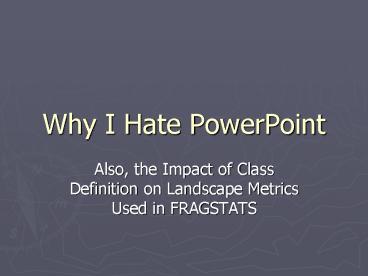Why I Hate PowerPoint - PowerPoint PPT Presentation
1 / 21
Title:
Why I Hate PowerPoint
Description:
Why I Hate PowerPoint Also, the Impact of Class Definition on Landscape Metrics Used in FRAGSTATS The Details Consolidate Classes from Lab 1 Apply the same metrics to ... – PowerPoint PPT presentation
Number of Views:107
Avg rating:3.0/5.0
Title: Why I Hate PowerPoint
1
Why I Hate PowerPoint
- Also, the Impact of Class Definition on Landscape
Metrics Used in FRAGSTATS
2
The Details
- Consolidate Classes from Lab 1
- Apply the same metrics to data from the same year
(2001). - Observe results
- Interpret results
3
Original Classes
- Following Slides Contain a List of the Original
Classes. - More than 30 classes.
4
Class Description
111 Developed Highly (gt75 impervious surface)
112 Developed Moderately (50-75 impervious surface)
113 Developed Lightly - wooded (25-50 impervious surface)
114 Developed Lightly - unwooded (25-50 impervious surface)
120 Cultivated (actively tilled, fallow and recently abandoned)
131 Grassland unmanaged (grazed land, old fields, abandoned land)
132 Grassland managed (golf courses, residential/corporate lawn, parks)
133 Grassland airport
5
141 Upland Forest Coastal Plain Oak dominant (Oak gt 75)
142 Upland Forest Coastal Plain Oak-pine (Oak 50-75)
143 Upland Forest Coastal Plain Pine-oak (Pine 50-75)
144 Upland Forest Coastal Plain Pine dominant (Pine gt 75)
145 Upland Forest Highlands/Piedmont deciduous - mixed hardwoods dominant
146 Upland Forest Highlands/Piedmont mixed deciduous/coniferous - hemlock/pine
147 Upland Forest Highlands/Piedmont mixed deciduous/coniferous - red cedar/pine
148 Upland Forest Highlands/Piedmont coniferous - hemlock/pine dominant
149 Upland Forest Highlands/Piedmont coniferous - red cedar/pine/plantation dominant
6
151 Upland Scrub/Shrub Coastal Plain mixed deciduous/coniferous
152 Upland Scrub/Shrub Coastal Plain mixed deciduous/coniferous - maritime/dune
153 Upland Scrub/Shrub Highlands/Piedmont mixed deciduous/coniferous
160 Barren soil/rock (sand/gravel pits, barren lt 25 vegetation)
200 Marine/Estuarine Unconsolidated shore
210 Estuarine emergent marsh
230 Riverine/lacustrine/palustrine emergent marsh mixed species
241 Wetland Forest Coastal Plain hardwood swamp (gt66 deciduous)
242 Wetland Forest Coastal Plain pine lowland (gt66 evergreen)
7
243 Wetland Forest Coastal Plain mixed - hardwood/white cedar-pine-holly
244 Wetland Forest Coastal Plain white cedar swamp (gt66 evergreen)
245 Wetland Scrub/shrub Coastal Plain mixed
246 Wetland Forest Highlands/Piedmont hardwood swamp (gt66 deciduous)
247 Wetland Forest Highlands/Piedmont mixed - hardwood/hemlock/white cedar/pine
248 Wetland Forest Highlands/Piedmont conifer swamp - hemlock/cedar/pine dominant (gt66 evergreen)
249 Wetland Scrub/shrub Highlands/Piedmont mixed deciduous/evergreen
250 Water
8
Consolidation
- ArcView condition (con) command.
- All Urban Classes ? 1 Developed Class.
- All Upland Forest Classes ? 1 Class.
- Wetland Forest Classes ? 1 Class.
- Some Classes not combined (pasture, fresh/salt
water marsh, water, bare soil).
9
30 Classes Down to 12 Classes
Class Land Use
1 Developed
2 Cultivated
3 Grassland
4 Upland Forest
5 Upland Shrub
6 Barren Soil/Bare Rock
7 Marine/Estuarine Unconsolidated shore
8 Estuarine emergent marsh
9 Riverine/lacustrine/palustrine emergent marsh mixed species
10 Wetland Forest
11 Wetland Shrub
12 Water
10
What Are the Impacts?
VS
11
Original (Landscape)
Metric
Year NP LPI TE SIDI
1984 2854 13.049 17445277 0.8882
1995 2823 12.9369 17476200 0.8869
2001 2865 11.688 17683680 0.8918
12
Modified (Landscape)
Metric
Year NP LPI TE SIDI
1984 1599 13.359 13387448 0.8015
1995 1572 14.0912 13553033 0.8012
2001 1590 14.8211 13773480 0.8039
13
(No Transcript)
14
(No Transcript)
15
PD Conclusions
- Combined? only shows slight increased in PD
- Original ? Class 112 increases the most while
Class 113 is has the highest total PD. - Loss of detail, information.
16
(No Transcript)
17
PLAND Conclusions
- Combining classes increases PLAND vs classes that
were not combined. - Graph two only shows increased trend in the
developed class. - Detail is lost.
18
(No Transcript)
19
COHESION Conclusions
- Graph two only shows a slight increase in
cohesion for Class 1. - In Graph one 111 decreases, 112 increases, 113
decreases, and 114 decreases in 1984 then
increases by 1995. - Detail.
20
Conclusions
- Impact on Landscape metrics was straight-forward.
- Loss of detail in class-level metrics.
- Change relationships between patches and classes.
21
The End
- Annoying Sound Effects!
- Graphs!
- Amazing Special Effects!
- This is even better than a Duck Tales Episode!































